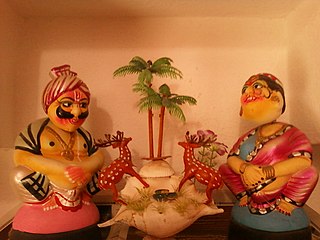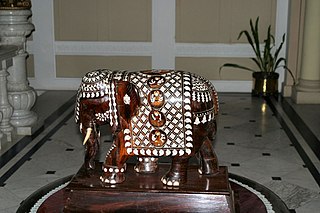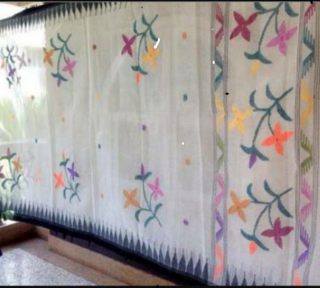
Pandanus is a genus of monocots with some 750 accepted species. They are palm-like, dioecious trees and shrubs native to the Old World tropics and subtropics. The greatest number of species are found in Madagascar and Malaysia. Common names include pandan, screw palm, and screw pine. They are classified in the order Pandanales, family Pandanaceae.

Zardozi or Zar-douzi, also Zardosi (Persian: زَردوزی,is an Iranian embroidery type. Zardozi comes from two Persian words: zar or zarin meaning 'gold', and dozi meaning 'sewing'. Zardozi is a type of heavy and elaborate metal embroidery on a silk, satin, or velvet fabric base. Designs are often created using gold and silver threads and can incorporate pearls, beads, and precious stones. It is used as decoration for a wide range of applications, including clothes, household textiles, and animal trappings. Historically, it was used to adorn the walls of royal tents, scabbards, wall hangings and the paraphernalia of regal elephants and horses.

Pandanus utilis, the common screwpine is, despite its name, a monocot and not a pine. It is native to Madagascar and naturalised in Mauritius and the Seychelles.
Reed mats are handmade mats of plaited reed or other plant material.

Kondapalli Toys are toys made of wood in Kondapalli of Krishna district, a nearby Vijayawada in the Indian state of Andhra Pradesh. Bommala Colony translates to Toys Colony in Kondapalli is the place where the art of crafting takes place. It was registered as one of the geographical indication handicraft from Andhra Pradesh as per Geographical Indications of Goods Act, 1999. These toys were one of the varieties of toys assembled in the houses during the festivals of Sankranti and Navratri and is referred as Bommala Koluvu.

Pedana Kalamkari also known as Machilipatnam style of Kalamkari work which involves vegetable dyed block-painting of a fabric. it is produced at Pedana a nearby town of Machilipatnam in Krishna district of the Indian state of Andhra Pradesh. It was registered as one of the geographical indication from Andhra Pradesh under handicraft goods by Geographical Indications of Goods Act, 1999.
The Geographical Indications of Goods Act, 1999 is a sui generis Act of the Parliament of India for protection of geographical indications in India. India, as a member of the World Trade Organization (WTO), enacted the Act to comply with the Agreement on Trade-Related Aspects of Intellectual Property Rights. The GI tag ensures that only those registered as authorised users are allowed to use the popular product name. Darjeeling tea became the first GI tagged product in India, in 2004–05, since then 370 goods had been added to the list as of August 2020.

Bagh print is a traditional Indian handicraft originating in Bagh, Dhar district of Madhya Pradesh, India. The process is characterised by hand printed wood block relief prints with naturally sourced pigments and dyes. Bagh print motifs are typically geometric, paisley, or floral compositions design, dyed with vegetable colours of red and black over a white background, and is a popular textile printing product. Its name is derived from the village Bagh located on the banks of the Bagh River.
Ganjam Kewda Rooh is a plant native to the Indian state of Odisha primarily in the Ganjam district. Kewda has been identified as a Geographical Indications in India.

Mysore Rosewood Inlay covers a range of techniques used by artisans in around the area of Mysore in sculpture and the decorative for inserting pieces of contrasting, often coloured materials like ivory shells, mother-of-pearl, horn and sandalwood into depressions in a rosewood object to form ornament or pictures that normally are flush with the matrix. These artifacts are manufactured in around the region of Mysore, these artifacts have been awarded Geographical Indication tag from the Government of India in 2005 due to its historic representation as an artifact depicting the region and the design and style used by the local artisans

Sankheda furniture is colourful teak wood furniture of Gujarat, India, treated with lacquer and painted in traditional bright shades of maroon and gold. It is made in Sankheda village and hence its name. The village is located about 45 kilometres (28 mi) from Vadodara.
Kuthampally dhoties and set mundu are dhoties and set mundus manufactured by the weavers in the Kuthampally region in Kerala, India. This clothing product has been registered under Sub-section (1) of Section 13 of the Geographical Indications of Goods Act, 1999 with effect from 13 November 2015. The registration was recorded as per an application made by Kuthampully Handlom Cluster Charitable Society Consortium.

Brass broidered coconut shell craft of Kerala is the craft of making beautifully carved and brass broidered products like cups, flower vases, snuff boxes, nut bowls, powder boxes and spoons using coconut shells as practiced by the artisans of Kerala in India. This art requires great skill on the part of the artisan as the shell is extremely hard. The main centres of production in Kerala are located in Thiruvananthapuram and Kozhikode Districts. Though the coconut shell craft is also prevalent in Goa, Tamil Nadu, Pondicherry, Andaman and Nicobar Islands and West Bengal, the brass broidered variety is practiced only in Kerala.
Navalgund durries, geographically tagged in India, are woven durries or a type of Indian rug with geometric designs, birds, and animal designs from Navalgund in Dharwad district of Karnataka, India
Malabar pepper is a variety of black pepper that originated as a chance seedling in a geographical region that now forms part of the present-day state of Kerala in India. The area of production of this variety of pepper now covers all the regions that are part of the Malabar Coast. Malabar pepper was one of the commodities most sought after by the ancient Roman and Arab traders, and later by the early European navigators.
Budithi Bell and Brass Craft are the products made out of alloy like brass at Budithi, a village in Srikakulam district of the Indian state of Andhra Pradesh. It was registered as one of the geographical indication handicraft from Andhra Pradesh as per Geographical Indications of Goods Act, 1999. It was registered as one of the handicraft in the geographical indication from Andhra Pradesh by Geographical Indications of Goods Act, 1999.

The Villianur Terracotta Works are handicrafts made from fine green clay, fine sand and thennal which are hand made by villagers of Villianur, in the union territory Pondicherry also spelled Pudhucherry, India. It has a history of more than 20 generations.

The Nachiarkoil lamp, also called Annam lamp or Nachiarkoil Kuthuvilakku, is an ornamental brass lamp made of series of diyas, a handicraft product which is exclusively made by Pather (Kammalar) community in Nachiyar Koil town in Tamil Nadu, India. The lamp, which is hollow cast, is made in different sizes and consists of four parts which are screwed together. The central pillar that crowns at the apex is called the "Prabhai"; it is generally in the form of a hamsa or swan. The lamp may also be made in the form of a female figurine holding a shallow bowl in a standing posture, or in the form of branches of a tree; the bowl of these lamps has five V-shaped spouts which hold cotton wicks, and is filled with oil for lighting. The ornamental lamps are widely used in temples in South India.

Wangkhei Phee is a textile fabric made of white cotton. It is a product which is protected under the GI registration and is made throughout the Indian state of Manipur and is woven by women. The fabric is transparent, has many designs on its body, and is popularly worn by women of Manipur for marriage ceremonies and other festive occasions.
Shaphee Lanphee is a traditional textile fabric woven and embroidered, usually as a shawl, with embroidered motifs with cotton threads generally by Meitei women of Manipur. The fabric was, in the past, presented as a gift of honour to the soldiers for their bravery in a successful war, and to the praise-worthy chiefs of the Nagas of Manipur by the king of Manipur. It is a product which is protected under the GI registration and is now made throughout the Indian state of Manipur.












